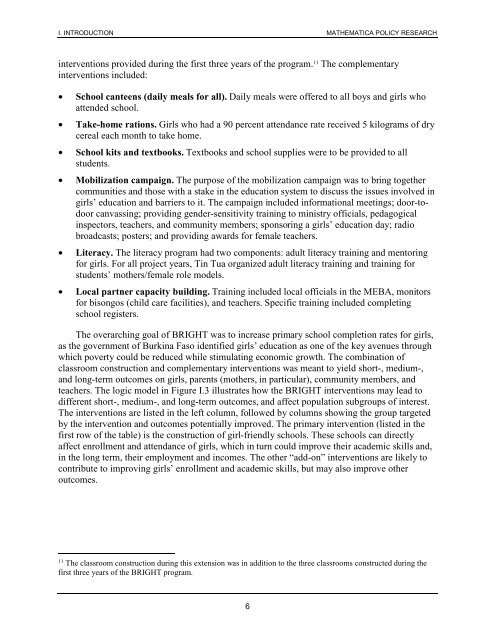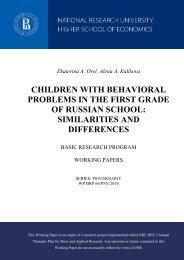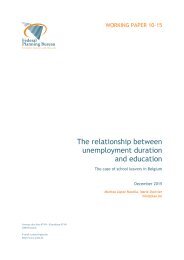Ten-Year Impacts of Burkina Faso’s BRIGHT Program
n?u=RePEc:mpr:mprres:2ecdd42bb503422b802ce20da2bf64b7&r=edu
n?u=RePEc:mpr:mprres:2ecdd42bb503422b802ce20da2bf64b7&r=edu
Create successful ePaper yourself
Turn your PDF publications into a flip-book with our unique Google optimized e-Paper software.
I. INTRODUCTION MATHEMATICA POLICY RESEARCH<br />
interventions provided during the first three years <strong>of</strong> the program. 11 The complementary<br />
interventions included:<br />
• School canteens (daily meals for all). Daily meals were <strong>of</strong>fered to all boys and girls who<br />
attended school.<br />
• Take-home rations. Girls who had a 90 percent attendance rate received 5 kilograms <strong>of</strong> dry<br />
cereal each month to take home.<br />
• School kits and textbooks. Textbooks and school supplies were to be provided to all<br />
students.<br />
• Mobilization campaign. The purpose <strong>of</strong> the mobilization campaign was to bring together<br />
communities and those with a stake in the education system to discuss the issues involved in<br />
girls’ education and barriers to it. The campaign included informational meetings; door-todoor<br />
canvassing; providing gender-sensitivity training to ministry <strong>of</strong>ficials, pedagogical<br />
inspectors, teachers, and community members; sponsoring a girls’ education day; radio<br />
broadcasts; posters; and providing awards for female teachers.<br />
• Literacy. The literacy program had two components: adult literacy training and mentoring<br />
for girls. For all project years, Tin Tua organized adult literacy training and training for<br />
students’ mothers/female role models.<br />
• Local partner capacity building. Training included local <strong>of</strong>ficials in the MEBA, monitors<br />
for bisongos (child care facilities), and teachers. Specific training included completing<br />
school registers.<br />
The overarching goal <strong>of</strong> <strong>BRIGHT</strong> was to increase primary school completion rates for girls,<br />
as the government <strong>of</strong> <strong>Burkina</strong> Faso identified girls’ education as one <strong>of</strong> the key avenues through<br />
which poverty could be reduced while stimulating economic growth. The combination <strong>of</strong><br />
classroom construction and complementary interventions was meant to yield short-, medium-,<br />
and long-term outcomes on girls, parents (mothers, in particular), community members, and<br />
teachers. The logic model in Figure I.3 illustrates how the <strong>BRIGHT</strong> interventions may lead to<br />
different short-, medium-, and long-term outcomes, and affect population subgroups <strong>of</strong> interest.<br />
The interventions are listed in the left column, followed by columns showing the group targeted<br />
by the intervention and outcomes potentially improved. The primary intervention (listed in the<br />
first row <strong>of</strong> the table) is the construction <strong>of</strong> girl-friendly schools. These schools can directly<br />
affect enrollment and attendance <strong>of</strong> girls, which in turn could improve their academic skills and,<br />
in the long term, their employment and incomes. The other “add-on” interventions are likely to<br />
contribute to improving girls’ enrollment and academic skills, but may also improve other<br />
outcomes.<br />
11<br />
The classroom construction during this extension was in addition to the three classrooms constructed during the<br />
first three years <strong>of</strong> the <strong>BRIGHT</strong> program.<br />
6







